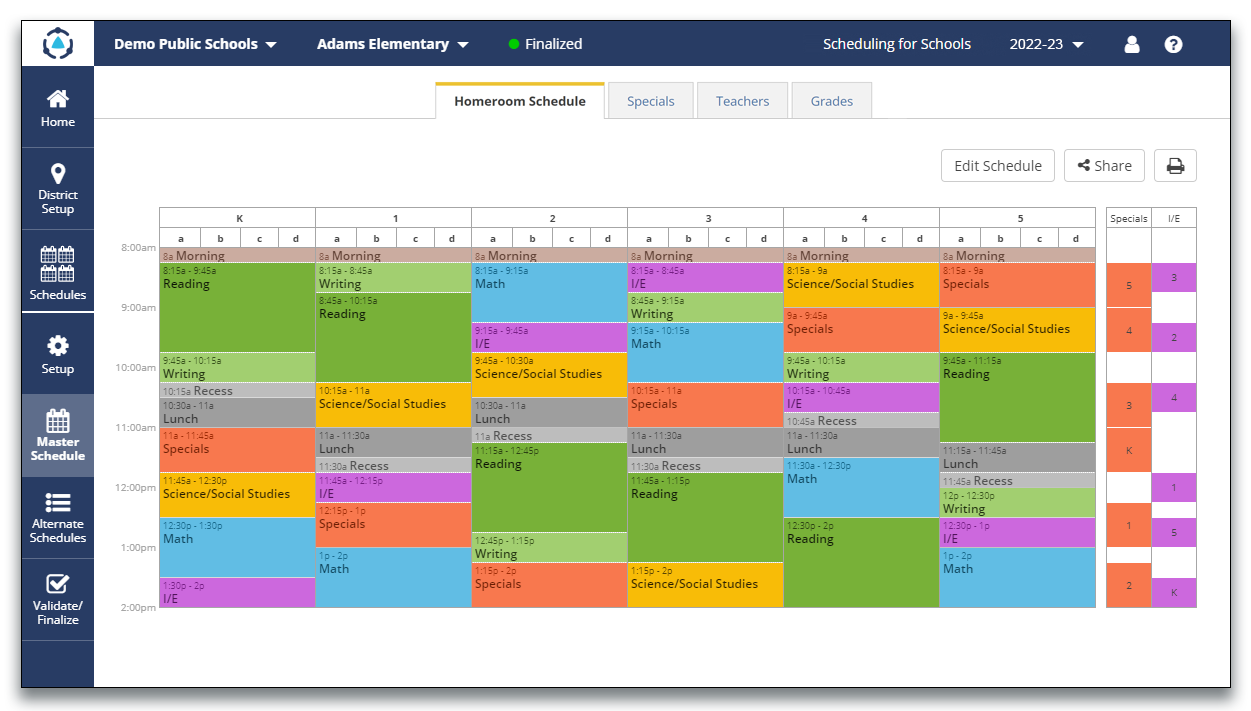
Building an Elementary Schedule - Part 6: Core Instruction School Scheduling
This 12-part series on How to Build an Elementary School Schedule offers step-by-step guidance and proven scheduling strategies for creating a better elementary school schedule.
There are a variety of approaches utilized for scheduling core instruction (e.g. ELA and Math). Many principals schedule core subjects while others communicate the required minutes to individual homeroom teachers so teachers can schedule these independently. This latter practice is not as common as it can have a negative impact on the efficiency and impact of school schedules and coordination of staffing and resources.
Almost all principals or the designated school scheduler, schedule specials, lunch, and recess. Scheduling core instruction for all grades and subjects can, however, be coordinated at the school level with tremendous benefits for all students and teachers.
For this reason, we recommend someone at the building level, who can see all of the constraints, staffing, and needs across the entire school, schedules core ELA and Math and Intervention/Enrichment after scheduling specials, lunch, and recess.
Coordinating and scheduling ELA and Math instruction at the building leadership level unlocks powerful opportunities for improving student support and strengthening student learning. As you place core blocks on your schedule, you'll leverage your instructional minute guidelines and push-in/pull-out rules.
Implement grade-level instructional minute guidelines to ensure students receive equitable access to minutes of instruction
Use your instructional minute guidelines to schedule core ELA and Math blocks. Ensuring that district instructional minutes are defined for each grade level ensures that clear expectations are set and that all students receive the appropriate and equitable amount of core instruction each day. This is especially important when multiple elementary schools exist in your district. Small variations in instructional minutes each day can add up to large variances in instruction across the school year (e.g. 5 minutes less each day = 15 fewer hours of instruction across the school year).
Stagger ELA and Math blocks within the schedule to maximize the impact of student services and support providers
Staggering ELA and Math allows you to maximize opportunities for push-in and pull-out support throughout the day. If your instructional guidelines allow coaches, interventionists, and special education teachers to deliver push-in support during core subjects, stagger these blocks by grade throughout the day to allow more staff to move from grade to grade and maximize regrouping strategies. In addition, staggering ELA and Math across grades helps stagger other periods during the day. For students who need additional support, this can present opportunities to deliver pull-out services during other periods, pending your guidelines.
Clarify components of core blocks to improve the transparency of push-in support opportunities
Your instructional minute guidelines may have started with a minimum ELA block of 90 minutes. Consider breaking down the 90 minutes of ELA instruction into smaller components of instruction. This will clarify when push-in support can be provided if you allow push-in support during certain components. The following are examples of ELA block decomposition that can help guide push-in support:
Define blocks based on instruction type (whole class or small group).
Define blocks according to their components (phonics, guided reading, independent reading, etc.)
Define block by the curriculum (reading workshop, writing workshop)
For example, if push-in support is allowed during small-group instruction but not during whole-group instruction, you can create a small-group block (e.g. 20 minutes) that follows a whole-group block (e.g. 70 minutes) to help teachers and support staff schedule push-in/in-class student services.
Building a schedule as a team leverages available expertise, builds buy-in, and improves schedule adoption
For team members who have historically had the autonomy to create their own schedules, switching to a coordinated, school-level approach may represent a significant change. For this reason and to ensure staff expertise and insights are incorporated into scheduling decisions, we suggest schools create scheduling teams that include principals, special education and curriculum leaders, and grade-level teachers. The team approach to scheduling enables everyone to become more aware of scheduling goals, staffing constraints, and tradeoffs. In addition, it encourages student-centered discussion and improves schedule adoption.
As a school or district leader, you have the challenge of maximizing your limited resources to improve student outcomes. Teamwork can help people understand this responsibility as well as broaden ideas for improving student achievement.
Take advantage of the coordinated, school-level approach to scheduling core instruction to improve supports and strengthen student learning!
Need Support with Scheduling?
DMSchedules Can Help.
The key to scheduling success is preparation and planning. Start taking action now so that you and your scheduling team are well-positioned for success this scheduling season. If you need help building your elementary school schedule, reach out to us. We can take scheduling off your plate, and create your school schedule aligned with your learning goals.

